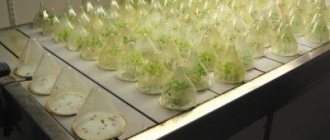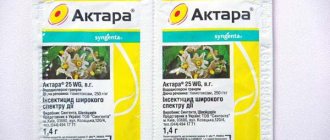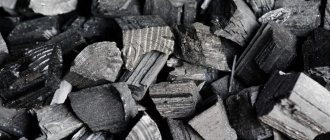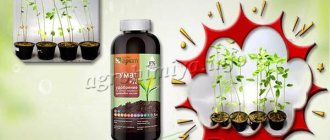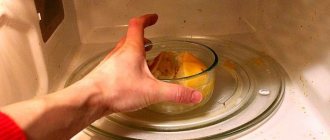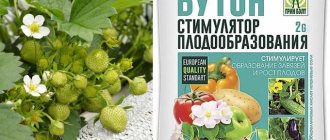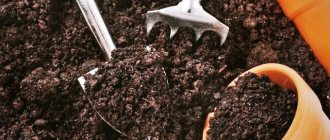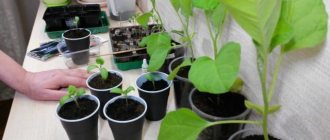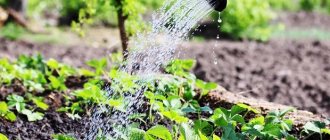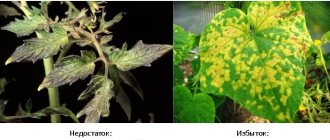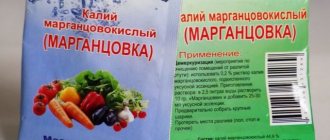What is potassium humate
The main element of such fertilizer as potassium humate is humic acid. This substance helps normalize soil acidity . Its use stimulates the development of various plant species, such as:
- flowers growing on home windowsills and in open ground;
- fruit trees;
- vegetables and legumes.
The formula of the substance is quite complex . In addition to acid, this fertilizer contains various amino acids, phosphorus, enzymes, growth stimulants and many other components in sufficient quantities.
Potassium humate, the composition of which stimulates metabolic soil processes, is found in large quantities in silt, peat and other soils. Currently, they have learned to produce this drug from a variety of substances, such as:
- Brown coal.
- Peat.
- Sapropels.
- All kinds of soils.
In appearance it is a brown powder . In some cases, a liquid concentrate is produced. The fertilizer is widely used for feeding plants, planted seedlings, stimulating the development of the root system in cuttings and seed germination.
Of course, you cannot assume that if you use humate, you are guaranteed a healthy harvest. This is not the solution to all problems. First of all, it is worth understanding that the substance fully manifests itself on soils with low acidity. Iodine, superphosphate and potassium fertilizers should not be used simultaneously with this fertilizer. When interacting with them, poorly soluble compounds are formed. The interval between the addition of these substances should be more than five days. Humate is also not very effective on chernozem soils .
Humate, humic fertilizers and stimulants: composition and features of use
Agricultural producers and farmers often face the problem of reduced yields or slow growth of crops, even on fertile soils and with the application of high-quality organic fertilizers. The fact is that during the growing process they use chemical fertilizers and harmful chemicals, which gradually deplete the soil and change its structure. As a result, plants simply do not receive enough nutrients and moisture from the soil. Humate fertilizer will help solve this problem.
– a unique agrochemical product that has amazing abilities to increase seed germination, crop yields and improve soil composition.
Gumat
cannot be clearly attributed to either fertilizers or plant hormones. The most suitable definition for it is a hormone-like substance. At the moment, humates are considered to be completely new agrochemicals that have a beneficial effect on all types of plants, although research into the characteristics of their effects is still ongoing.
What does humate
?
Any humic fertilizer consists of humic acids with the addition of microelements and fulvic acid salts.
Visible effect of humates and leonardites on plants
Feedings of this type are usually divided into several types:
- Industrial ones are produced from organic waste
(for example, the pulp and paper industry) and brown coal. The scope of their application is quite extensive and includes construction, land reclamation, livestock farming and even medicine. It is not recommended to use them in plant growing, since humates of this type contain a lot of carbon, and some contain impurities of heavy metals. - Natural ones are specially designed for crop production.
They are produced from natural soil deposits, since humic acids are a natural component of humus, a nutrient component of the soil. - Ballast-free humates are natural substances
that can be easily identified by their appearance. They are moist, have a lumpy structure and are most often black or dark brown in color, in contrast to the gray granular industrial humates. - Ballast is not recommended for use as fertilizers
, since the content of microelements and other substances beneficial to plants is reduced. However, their composition allows the use of ballast humates as growth stimulants and strengthening agents for agricultural crops. It has been proven that ballast humates have the maximum effect on potatoes, which are grown on soils with low fertility, and flower crops.
Humate based on leonardite and peat
In addition, humates are usually divided into types depending on the type of salts included in their composition. Most often, potassium and sodium salts are used for production, but in some cases the use of ammonium is also allowed.
The most common is potassium humate
. It is neutral in chemical reaction, has optimal acidity, and additional enrichment with microelements allows it to be used for processing planting material, feeding and stimulating seedling growth.
In sodium humate
Quite high acidity (up to 10 units), so its use on alkaline soils is contraindicated. Moreover, such fertilizers have the ability to increase plant resistance to diseases, frost, drought and other unfavorable conditions.
Despite some differences between potassium and sodium humates, they can be used alternately. Modern manufacturers offer various types of packaging of these products: dry granular in bags or boxes, or liquid, in the form of a concentrated suspension.
Application of humates. Features of the impact on crops and soil
The effect of humates on plants and soil is still being studied, but at the moment scientists have already managed to identify several criteria for the impact of these substances. Application of humates
has the following effects:
- Mechanical: improve the structure of the soil
depending on its type. For example, loose soil becomes more viscous, while dense soil allows air and moisture to pass through better. - Chemical: improve the composition of the soil
, creating a favorable environment for the development of beneficial microorganisms, and inhibit harmful bacteria. - External (for plants): improve the transport of nutrients
to the stems and leaves; - Internal (for plants): penetrating inside the stems, they enhance redox processes
, synthesize the formation of plant hormones and prevent the formation of nitrates.
In addition, the use of potassium humates
and sodium helps neutralize toxins and heavy metal ions, making crops truly organic and safe.
After treating a field or bed with humates, a positive effect can be noticed almost immediately. Plants grow faster and become more resistant to aggressive environmental factors. In other words, when the effectiveness of humates is finally confirmed, they will become a new word in agriculture. One or more treatments of seeds and seedlings will be enough for the plants to sprout faster and for a larger harvest even on poor soils.
Environmental friendliness of Gumatov
All types of humates belong to the lowest, 4th hazard class. In other words, they are absolutely safe for human health and do not harm the environment.
However, certain contraindications for them still exist.
Humates cannot be used in combination with calcium nitrate and phosphate fertilizers, since in this case compounds are formed in the soil that do not dissolve for a long time or are not eliminated at all. If there is a need to use these fertilizers, humates are first added to the soil, and after 3-5 days chemical fertilizers are added.
Scope of application of leonardites and humates
Humates are commonly used in several ways.
- Firstly, solutions of ballast-free humates are used for pre-sowing treatment of seeds.
- Secondly, during the period of growth and fruiting, fertilizing is carried out with weak solutions (concentration no more than 0.1%).
In addition, these preparations can be used to detoxify the soil; in this case, preference should be given to dry ballast-free species, such as Irkutsk humates (leonardites)
. Also, solutions of ballast-free humates can be used to treat manure and compost (about 3 months before application to the soil).
As research into humates continues, their scope of application is constantly expanding. For example, the effectiveness of these products has recently been proven when treating poor greenhouse soils.
Next, we will take a closer look at the ways to use humates at various stages of growing plants.
You can also read additional articles
- Features of the use of humates (leonardites) in closed ground (greenhouses)
- Humates and yield - application on grains and vegetables
- Technology for using Irkutsk humates in growing grain crops
- Humates against frost
- Feeding fruit trees with humates
- Application of humates on potatoes. Fertilizers for Potatoes BULBA
- Efficacy of humates (leonardites) against plant diseases
Pre-sowing seed treatment
To process planting material, prepare a working solution of humates from 5-6 grams of dry matter dissolved in 10 liters of water. In a solution of liquid humate
you need to soak the seeds: potatoes for 12 hours, cabbage seeds for 48 hours, seedlings or tomato seeds for three days, and any other seeds for a day.
If you are going to process seeds and not tubers or cuttings, you can fill them with hot water (temperature no more than 60 degrees) and let them cool for 24 hours. For cuttings that do not root well (for example, conifers), it is recommended to prepare a more concentrated solution. In this case, the concentration should be 3 tablespoons per bucket of water.
For those who are afraid of violating the dosage, we recommend buying liquid humates
- This is a solution of the required concentration, ready for use. In the future, it can be easily dosed with a regular medical syringe without a needle.
Plant nutrition
Fertilizing crops with humates is carried out by spraying, since during normal watering the solution of the substance can cause burns to the leaves.
For proper use of humates
follow these
instructions
:
- Green plants, root crops and bulbous plants are processed about 4 times during cultivation, but no later than two weeks before the start of harvest;
- Cucumbers, tomatoes and eggplants are fed by watering at the root during transplantation of seedlings into the ground, and during the growing season they are watered at the root with a 0.05% solution per square meter.
- Carrots, peppers, cabbage, pumpkins and beets are also fed, but watering or spraying should be done weekly until the fruits begin to ripen.
- Fruit and berry crops are sprayed from the beginning of bud swelling until fruit formation, but any treatment should be stopped a week before harvest.
For feeding, it is better to use ready-made liquid humates, which are already diluted in the required concentration.
Detoxification and compost treatment
As mentioned above, humates can not only increase seed germination and yield, but also improve the quality of the soil in general.
To detoxify the soil, you will need dry humate, which is mixed with sand and evenly distributed over the surface of the soil. In this case, 5 grams of substance will be needed per square meter of area.
It is better to carry out processing on wet melting snow or immediately after it melts, while the soil is still moist. This treatment eliminates heavy metals and radionuclides from the soil, making it more suitable for agriculture.
Humates have a similar effect on manure or compost. Just 10 grams of the substance per 10 kg of raw materials can improve its quality and increase crop yields. The dry substance must be diluted in water to create a solution with a concentration of no more than 0.1% and evenly sprayed with manure or compost.
How to choose a suitable humate?
Fortunately, there are few fakes among humates, since the production of counterfeit products is much more expensive than production using the correct technology.
Various natural substances are used to produce humates: brown coal, sapropel, vermicompost, peat and leonardite.
All these substances contain humic acids in different concentrations, which serve as the basis for humates.
For example, brown coal can contain up to 10% acids, while in vermicompost this proportion is no more than 2%. The leaders in the content of humic acids are sapropel (up to 15%), peat (10-20%) and leonardite, which can contain up to 80% humic acids
. It is the latter substance that is most often used in the production of humates.
You can read more in our article Humates and Humic preparations from different sources, which one to choose?
In addition to the high content of humic acids, leonardite has a number of other advantages that distinguish it from other materials for the production of humates. Firstly, its formation requires a long time, during which the substance is completely cleared of harmful impurities. Secondly, it does not contain heavy metal ions and radionuclides, therefore it is absolutely safe for plants.
Sapropel humates are affordable, but the finished substance may contain harmful impurities.
The largest share on the market is occupied by peat humates: they are inexpensive, the concentration of useful substances in them is quite high, and there are completely no harmful impurities.
It should also be noted that the most favorable combination of biological activity (increasing productivity in crop and livestock production), agrogeochemical properties (detoxification and improvement of soil fertility), as well as environmental friendliness of production, relate to the greatest extent to humic preparations produced from leonardite deposits located in the Irkutsk region. areas. The profitability of using these preparations is much higher than those produced from raw materials that initially contain a high proportion of ballast substances (peat, lignin, sapropel).
Some interesting facts
If you are skeptical about humates and are not sure of their effectiveness, we will try to give you some amazing factors that prove the benefits of humic acids and humates.
The largest deposits of organic sediments rich in humic acids are located in the Irkutsk region and Sakhalin. For these regions, plant gigantism is considered the norm. For example, on Sakhalin you can often find giant burdocks, and in the Baikal region they grow buckwheat as tall as a man. At the same time, the plants do not lose their properties and remain useful to humans.
Manufacturers of agrochemicals have been successfully producing potassium humates “Baikal” and “Sakhalin” for several years in a row, which are appreciated by many gardeners and gardeners. These liquids can be used both for pre-sowing seed treatment and for feeding crops during the growing season.
From the above factors we can conclude that nature itself proves the benefits of humates, and we can only wisely use the gifts of nature.
Application of sodium humate for feeding garden and vegetable crops
One of the frequently used organic plant growth stimulants is sodium humate. It has a positive effect on the growth and development of garden crops. A universal fertilizer improves the structure and composition of the soil, increases its moisture capacity, air permeability, and helps convert insoluble salts into forms that are easily accessible to plantings. To maximize the effect of the natural humates used, you need to know how and when to apply them.
Compound
Depending on the raw materials used, the composition of the fertilizer can be different - organic or organomineral. Based on this factor, humates are divided into two types - potassium humate and sodium humate. Both drugs are similar in their characteristics. Let's take a closer look at how their composition differs.
Composition of potassium humate
Under the influence of this drug, the soil is saturated with useful elements that can improve the biological, chemical and physical parameters of the soil. Thanks to this, crop yields increase, their growth is stimulated and their quality improves.
This product belongs to organomineral fertilizers made from peat. In addition to the high content of potassium salts of humic acids, the composition of potassium humate is saturated with low molecular weight fulvic acids and amino acids. Also, the presence of active trace elements such as cobalt, copper, boron, molybdenum, zinc and manganese provides the drug with high value.
Potassium humate is characterized by neutral acidity and a wider sphere of action compared to sodium humate.
Composition of sodium humate
It is a powerful plant growth stimulator. Under its influence, the number of shoots increases, immune resistance to diseases and negative climatic factors (drought, high humidity, cold snaps) increases. The drug exhibits high adaptogenic and immunostimulating qualities.
Sodium humate is made from peat, less often from brown coal. The high pH content of humate makes it highly effective on alkaline soils. The drug prevents premature falling of leaves and ovaries. In plant growing, it is widely used in both liquid and dry form. The stimulant does not exhibit toxicity, it is not mutagenic and does not have cumulative properties.
The composition of sodium humate includes sodium salts of humic acids (70% of them in the substance). Microelements include molybdenum, copper, cobalt, manganese and zinc. Heavy metals include lead and cadmium. The dry composition contains nitrogen, phosphorus, potassium, magnesium, and calcium.
Humic acids in plant life
Organic fertilizer with a mineral complex has a positive effect on vegetables, berries, and indoor plants at all stages of the growing season. The microelements contained in its composition stimulate the growth of shoots, reduce the likelihood of inflorescences falling off, and increase resistance to stress factors in dry weather and during the season of excessive rainfall.
Sodium humate promotes effective fruiting, improves the taste and marketability of fruits, it is non-toxic and non-mutagenic.
Description of the drug
Beginning gardeners do not know what sodium humate is and how to use it correctly. This natural fertilizer consists of sodium and potassium salts of humic acids (fulvic acids and humic acids), which are formed in the soil due to the decomposition of fiber in plant organisms.
Peat, lake or brown coal are used to obtain humic acids. They are extracted using alkali, after which impurities are removed and neutralized. Next comes the process of preparing dry or liquid organic fertilizer. According to the description, the drug is a natural stimulant for the rapid growth of garden and household crops, including flowers and berry bushes.
Chemical composition
The main active component of sodium humate is sodium salts of humic acids. These are quite complex substances of organic origin, which are distinguished by the presence in their composition of over twenty types of amino acids, carbohydrates, proteins and some tannins. In addition, acids are a source of fats, waxes and lignin.
Types of humates
To boost the immunity of garden crops and increase productivity, two types of fertilizers are used - potassium humate and sodium humate. The second differs in composition, performance characteristics and application features.
Potassium humate
This is an organic type of fertilizer that is actively used when growing plants. The fertilizer is used when preparing seed material for planting in the ground, for processing potato tubers, cuttings of garden plantings, and indoor flowers. Due to its powerful stimulating properties, the substance accelerates the process of seedling survival and the emergence of rapid seedlings.
Potassium humate can be purchased in its pure form or additionally enriched with microelements in chelated form and amino acids.
Sodium humate
Fertilizer increases the content of biologically active components in living organisms, promotes the development of the root system of plants, prevents premature loss of green mass, and also extends the flowering period of perennial and annual crops.
There is a limitation in its use: unlike potassium fertilizer, this organic composition is unsuitable for alkaline soils.
Advantages and disadvantages
The main advantage: natural origin is a guarantee of environmental purity and safety for vegetable and horticultural crops.
Advantages of sodium humate:
- safe growth regulator, plant protection agent against pathogens;
- the use of the drug even in small quantities increases the phytoimmunity of plants;
- ensures not only an increase in yield, but also high quality products (keeping quality, taste, nutritional composition of vegetables and fruits);
- the drug neutralizes excess amounts of mineral fertilizers and replenishes the lack of oxygen in the soil;
- under the influence of humic substances, pesticides in the soil decompose faster and their accumulation decreases;
- in grain crops the synthesis of amino acids and protein is activated, in corn - sugars and protein, in sunflower - fats and B vitamins, in vegetables and root vegetables - sugars and vitamins;
- Unlike other growth stimulants, sodium humate is the simplest, harmless, affordable and quality preparation.
Features and nuances of application:
- the drug does not increase the amount of humus in the soil, but reduces the stressful situation in case of unfavorable humus conditions of the soil;
- humates are not a panacea for all ills and diseases; drugs cannot replace the normal structure of the soil, regular watering, scheduled application of mineral fertilizers and organic substances (compost, bird droppings, manure);
- the final mechanism of action of humates is not fully understood. But even at the beginning of the 20th century. domestic and foreign research scientists have proven the feasibility of their use in agriculture, animal husbandry and medicine;
- all humic preparations work more efficiently if there is a sufficient amount of nitrogen, phosphorus and potassium in the soil composition;
- The main purpose is that organic additives promote and help the plant take from the fertile layer all the nutrients that are already present in the soil.
Flaws:
- Biologists and plant experts warn: getting carried away and using any humic preparations uncontrollably is dangerous ! The effect may be the opposite. Microelements (iron, cobalt, molybdenum, zinc, etc.) are bound by salts of humic acids and become inaccessible to plants.
- An overdose of humic preparations can cause an acute shortage of microelements and disrupt the process of absorption of nutrients by the root system.
Benefits of using the drug
Among the positive characteristics of natural fertilizer are:
- increase in yield indicators by almost 30%;
- strengthening the underground and above-ground parts of plantings;
- beneficial effect after use;
- stimulation of photosynthesis and metabolism;
- acceleration of the fruiting process;
- increasing the resistance of plant organisms to negative environmental factors;
- replenishment of nutrients in the soil.
In addition, sodium humate contains environmentally friendly components that are absolutely harmless to human health and do not accumulate in planted crops.
Release form
In specialized retail outlets, sodium humate is presented in the form of liquid, powder and prompter.
Liquid
The most popular form of fertilizer among gardeners. Peat is used to make it, from which nutrients are extracted. Liquid fertilizer has a rich dark color. The liquid is easy to use and has a high degree of efficiency.
Before use, the concentrate must be diluted in a container with cold water. To treat the soil, it is enough to take 0.1-0.2% of the total volume of the natural product. To spray plants, use 0.01% of the total volume of fertilizer.
The liquid type of fertilizing can be combined with nitrogen and organic compounds.
Powder
This form of sodium humate is used as an immunostimulating organic agent that promotes rapid growth of vegetative organs and fruit ripening. The fertilizer is diluted in strict accordance with the instructions supplied with the preparation. Thus, seed treatment is carried out with a working solution prepared at the rate of 1 tsp. drug per liter of water. To till the soil in the fall, use a liquid of 1 tbsp. l. products and 10 liters of water.
Fertilizing strengthens the root system of plants and their above-ground parts. It activates beneficial microorganisms found in the soil, which increases the productivity of plants grown in the garden. The mineral complex effectively removes heavy metals from the soil. After cultivation, the land does not lose its quality characteristics, it becomes more fertile and enriched with nutrients.
Prompter
This universal organomineral composition is known for its positive effects on plant organisms. It is applied twice a month:
- The first feeding is carried out starting in March and ending in September.
- From October to February, it is enough to use fertilizer once a month.
The product is obtained by extracting microelements from humic sapropel, which is deposits in fresh water bodies. This is quite accessible material.
It is recommended to prepare a working solution before adding it to the beds. If you use fertilizer after long-term storage (in a diluted state), the effect may be the opposite - negative. Processing of seed material should be carried out exclusively with fresh working solution.
How to use humates correctly
Humates are applied at any stage of growth of cultivated crops. It is advisable to fertilize annuals at the initial stage of growth and before flowering. It is better to fertilize perennial crops propagated by seedlings after transplanting seedlings or trees. At this moment, their root system is inevitably injured and needs additional support.
Use humates correctly, and the harvest from your plot will be rich. They can be used in three ways - by soaking seeds or other planting material, watering crops at the root and foliar treatment.
The working solution of potassium humate is prepared in the following proportion - take a teaspoon of fertilizer (without a slide), this turns out to be approximately 1.5 g of powder. It is dissolved in 10 liters of water - in a standard bucket. The result is a solution with a concentration of 0.01-0.015%. The working fertilizer solution is used for soaking seed material, cuttings, for watering and for foliar feeding - spraying.
Vegetable seeds and potato tubers are soaked for various periods of time. For seed potato tubers, 12 hours is enough, tomato seeds need to be kept in the solution for three days, for cabbage 48 hours is enough, seeds of other vegetable crops are soaked for a day. You can enhance the effect of humates by first pouring hot water over the seeds, but not boiling water (the temperature should not exceed 80 °C).
Cuttings of trees and shrubs are also soaked in a solution of potassium humate. This significantly increases their rooting rate, by about 30-50%. Cuttings of shrubs and trees are soaked in the working solution; they need to be kept in it for 24 hours. As a result, planting material treated in this way produces a root mass twice as large as usual, and development is about a week ahead of untreated seedlings. The effect is secured by watering it twice with a humate solution. Plants with such care are more powerful, strong and healthy.
Norms for the consumption of humates have been developed for each type of plant. Of the total recommended amount of these fertilizers, a portion is allocated for the treatment of seeds and material, another portion is allocated for foliar feeding, and the remainder of the standard volume of humates is used to feed the root system of plants. It is strictly forbidden to exceed the recommended fertilizer rates; this can have the opposite effect - slow down the development of the cultivated crop and reduce productivity.
Humates are used as a separate, self-sufficient fertilizer, or in combination with other microelements and minerals beneficial to plants. Complex use enhances the beneficial effects of fertilizers.
An important property of humic fertilizers is their ability to accelerate the decomposition of various woody remains - hemicellulose, cellulose, etc., which ensures accelerated accumulation of the humus layer. The combination of humates and manure or compost can greatly accelerate the growth of microflora and reduce the consumption of these organic components by about five times. To achieve a similar effect, you need to treat manure and compost in advance, three months before adding them to the soil, with an aqueous solution of humic fertilizers. For every kilogram of organic matter, add 1 gram of humate diluted in water.
Scope of application
The drug based on natural components is used for:
- increasing the concentration of humus in the soil;
- preventing the accumulation of harmful chemicals in the soil;
- activation of beneficial microflora;
- better and faster rooting of young seedlings;
- reducing the use of agrochemicals;
- reducing the ripening period of fruits;
- increasing the nutritional and energy value of the crop;
- extending the shelf life of fruits without loss of taste and commercial qualities.
Sodium humate fertilizer can be used to feed plant organisms both in spring and autumn. Garden crops, including roses, have a strong root system after spraying them with an organomineral complex.
Tillage
After using sodium humate on a personal plot, the quality characteristics of the land are significantly improved and its detoxification is carried out. For these purposes, it is enough to scatter fertilizer at the rate of 50 g of the drug per 10 square meters. m area. It is more convenient to do this after pre-mixing the product with sand. Upon completion of the procedure, the soil must be loosened using a hoe or rake.
Another good option for soil treatment is spreading a mixture of sodium humate, ash and sand over the snow (in spring). This agricultural practice will prepare the area for the planting season.
After the snow has melted, you need to cover this bed with covering material and the ground will be ready for planting crops.
Pre-sowing preparation
To process seed material, you need to prepare a working solution at the rate of 0.5 g (1/3 teaspoon) of the drug and one liter of water. The seeds are placed in a container with diluted fertilizer and left for two days; for cucumbers and flowers, this period is reduced to one day. After this, they should be dried and can be placed in the ground.
Fertilizers for irrigation
In most cases, sodium humate is used at the beginning of the growing season, with an interval of 10-14 days. The optimal rate for one plant is 0.5 liters of solution, subsequently increased to one liter. In order for the seedlings to take root faster, it is recommended to feed them immediately after planting or 2-3 days later. The second feeding should be carried out during budding, and the third during flowering.
The working solution is prepared from 10 liters of warm water and 1 tbsp. l. organomineral composition. It is recommended to first dilute the humate in water, the temperature of which is +50 degrees, and then add the remaining volume of liquid. Liquid fertilizer is stored for a month; the place in which it is located should be dark and cool.
Foliar feeding
Irrigation on the leaf is carried out with a solution prepared from 1 tsp. drug and 10 liters of water. It is better to carry out the procedure in the morning or evening.
How to use sodium humate as fertilizer
Sodium humate is available as a fertilizer in liquid, powder or granular form:
- Sodium humate (liquid) “Barrel and four buckets” from the Russian company Ogorodnik, 600 ml – organic fertilizer for spring feeding of all garden and vegetable garden plants, including flowers and ornamental shrubs; consumption per 240 liters of finished solution.
- Sodium humate “Berries” , 500 ml – liquid organomineral fertilizer for berry crops, adaptogen and immunostimulant. Manufacturer: Sakhalin humates.
- Sodium humate “Flowers (garden and indoor)” , 500 ml – a natural growth stimulator, acts as a protective fungicide. The Sakhalin Humates company produces special preparations for seedlings, vegetables and a universal product for all garden crops.
- "Agro Gumate 80" (active ingredient 80%), 25 kg - the drug in powder form. Solubility in water is more than 80%. Average consumption – 50-100 g per 1 ha (for large areas). Used as an adaptogen, growth stimulator and soil cleaner (restorer) from pesticides, heavy metals and petroleum products.
- “Sodium humate Sakhalin” , 10, 30 g, manufacturer – Palisade. Organomineral fertilizer for summer cottages and small plots. The composition contains humic compounds - more than 80%, sodium salts - at the rate of 300 g per 1 kg.
Humic preparations:
- “Potassium and sodium humate with microelements” , 0.5 l, Simbirskhoztorg company - a natural growth stimulant, the drug is used for pre-sowing treatment of seeds and tubers, and for additional complex fertilizing.
- “Humate + 7 microelements” , packaging 10 or 50 g, manufacturer - Green Pharmacy for Gardeners - an adaptogen, a powerful stimulator of plant development, a complex of microelements and salts of humic acids.
- “Gumate + Iodine” , 25 g, August company - suitable for all plants, used for soaking seeds, feeding tomato seedlings, vegetables and adult plants. The product is not phytotoxic and does not accumulate in plant cells.
- "Gumel Lux" , 20 l - a complex preparation in liquid form, containing potassium and sodium salts of HA (10% concentrate), macro- and microelements. Completely soluble in water, ideal for grains, fruits and ornamental crops.
For open ground vegetable plants (tomatoes, cucumbers, cabbage), the use of sodium humate increases the yield:
- tomatoes for 50-60 c per 1 ha;
- cucumbers – 80 c;
- cabbage - from 40 to 100 c.
The effectiveness of fertilizing cucumbers and tomatoes in protected soil with sodium humate:
- cucumbers - the yield increases by 1.5-2 kg per 1 sq. m;
- tomatoes - 2-2.5 kg.
Instructions for use
Fertilizing green, bulbous and root crops with sodium humate is carried out 3-4 times throughout the entire growing season, but not earlier than 7-14 days before harvest. For these purposes, it is recommended to use liquid fertilizer. For cucumbers and nightshades, watering is carried out at the root with a working solution of 0.05% at the rate of 2 liters per 1 square meter. m. Foliar feeding is carried out once every 14 days, taking into account 3 liters of diluted humate per 1 sq. m. m.
The application of humic acids for feeding pumpkin, cabbage, beets, peppers, and carrots is done with a nutrient solution, as for cucumbers.
Spraying of fruit and fruit and berry crops with humate is carried out:
- until the leaves bloom, when flower buds are laid;
- at the budding stage;
- after flowering ends;
- upon completion of ovary formation.
According to the instructions for use, irrigation should be carried out 4 times per season.
Dosage
To properly dilute sodium humate in the required concentration, you first need to pour in 1 tsp. the drug onto a sheet of paper in a box and stretch it into a line. Using a needle, divide this amount into 5-6 parts, which will give each piece a weight of 0.5-0.6 g.
Compatibility with other tools
Humate can be effectively used together with pesticides, which will significantly increase the protective powers of plant organisms against major diseases.
It is not recommended to use organomineral fertilizer simultaneously with nitrogen compounds, since this component is already present in its composition. Excess nitrogen negatively affects the health of plantings.
To avoid the formation of insoluble sediment, this complex of nutrients is not combined with phosphorus compounds.
Precautionary measures
Before you start processing with sodium fertilizer, you need to take care of personal protective equipment. In case of contact with eyes, rinse thoroughly with clean water. In case of poisoning, it is recommended to drink 2-3 glasses of water.
What it is?
Potassium humate is a natural growth stimulator, a complex mixture of microelements and organic acids. It is made from peat and coal using alkaline reactions: humic acids are treated with potassium alkali. As a rule, this is a product of peat processing.
Historical reference. The effectiveness of humic substances was first discussed in the 19th century. Domestic scientists M.M. Kononova, L.A. Khristeva, I.V. Tyurin in research works in the 60-70s. The 20th century proved the feasibility of using sodium, potassium and ammonium humates in agriculture.
Humates are the final stage of decomposition of organic substances in the substrate. A complex of complex compounds and salts.
Beneficial features:
- the main and most important function is that in the right dosage, fertilizer stimulates the germination of seed;
- optimizes the processes of respiration and nutrition of crops;
- significantly (by 10-15%) increases the biomass and growth in length of seedlings and seedlings;
- mobilizes protective mechanisms - reduces and neutralizes the entry of heavy metal salts and radionuclides into plants from the soil and atmosphere;
- effective at all stages of the growing season;
- starter preparation - early treatments are especially useful;
- protects the plant from excess or lack of moisture, with low daily temperature changes in early spring;
- increases resistance to diseases and viruses (rot, fungi), to the effects of radionuclides and organic pollutants.
Kinds
The fertilizer is available in various forms and packaging intended for small areas and large areas.
The drug is commercially available in liquid and powder form, tablets, granules and capsules.
Liquid
Dark colored liquid with a characteristic odor. Packaged in cellophane bags or plastic capsules of 10, 30, 100 ml, in plastic bottles and canisters of 1.5 and 5, 10, 20 and 100 liters.
The liquid preparation contains up to 80% humate and 20% auxiliary compounds.
The main feature is its high concentration and stimulating effect on berry and garden plants.
Used for processing:
- strawberries;
- strawberries;
- vegetables and root vegetables (beets, cucumbers, tomatoes, peppers);
- garden and potted flowers;
- fruit trees;
- currant bushes, raspberries, gooseberries.
Farmers use complex fertilizers, for example Vympel, Vympel-2, which contain up to 30 g of potassium humate.
This is the latest development of the Dolina company. In the preparations of this company, humic acids are presented in a modified stable form and are intended for acidic and alkaline soils. The balanced composition of polyhydric alcohols, humic and natural carboxylic acids influence the growth and development of crops and regulate the energy metabolism of the plant at the cellular level.
What are “humates”?
Humic acids (another name for humates) are produced from peat, lake silt, and brown coal. Peat is most often used. Humic acids are extracted from it using alkali. Then comes the removal of impurities, neutralization and preparation of dry or liquid organic fertilizer.
Due to the high content of macro- and microelements and vitamins, many gardeners consider them a first-class fertilizer. In addition, humates are a natural stimulant for the rapid growth of garden and household crops.
Once in the soil, these substances activate the activity of soil microflora. As a result, there is an improvement in the soil structure and its quality characteristics.
Beneficial features
Humates have a positive effect on the growth and development of garden crops, as well as on the structure and qualitative composition of the soil:
- Normalize cellular metabolism, accelerate protein production.
- They simplify the survival of seedlings in open ground and promote the development of a powerful root system.
- They increase the immunity of garden crops, allowing them to more easily withstand unfavorable growing conditions: droughts, scorching sun, prolonged rains, hail, frosts.
- Suitable for any type of soil, reduces the level of heavy metals in the soil.
- They allow you to save on other fertilizers and enhance the effect of herbicides and insecticides.
- They do not harm the environment and allow you to grow environmentally friendly fruits.
Potassium humate: description, composition, mechanism of action
Potassium humate is a drug that has a stimulating effect on the growth and development of various crops. It can reduce the increased acidity of the soil and speed up metabolic processes in it.
The composition of potassium humate includes:
- macro- and microelements;
- humic acids (HA);
- bioactive amino acids;
- substances that affect plant growth;
- antibacterial components;
- wax, fats;
- amino acids and enzymes.
The composition may differ in the concentration of the components used, and depending on this, the scope of application changes.
Potassium stimulates the process of photosynthesis, promotes the formation of sugar and the movement of carbohydrates inside the crop.
Planting material (seeds, cuttings, seedlings) and adult plants are treated with potassium humate. Widely used in hydroponics.
You can fertilize with this stimulant in a variety of ways - by watering or soaking the seeds. This requires a 0.01% solution. The soil must be alkaline or podzolic. If you use humate on fertile lands (chernozems), you will not see a positive result. Fertilizers after this plant growth stimulator (GPP) should be applied no earlier than 4-6 days later.
What are they?
Potassium or sodium humate is used to feed garden crops. They vary in composition, properties, and application features.
Potassium humate
This organic fertilizer is widely used in crop production. It is especially relevant at the preparatory stage - seeds, potato tubers, cuttings of garden plants, shrubs, and flowers are treated with potassium humate. Thanks to its powerful stimulating properties, this substance promotes the rapid rooting of seedlings and the emergence of rapid seedlings.
Specialized stores sell both pure potassium humate and additionally enriched with essential microelements.
Sodium humate
Improves the immunity of plants, thanks to which they grow more productively and withstand unstable weather conditions. In addition, sodium humate inhibits premature leaf fall and prolongs the flowering period of perennials and annuals.
Important! Sodium humate, unlike potassium humate, is not suitable for alkaline soils.
Types of potash fertilizer and their properties
This fertilizer is natural and highly environmentally friendly. As mentioned above, several types of such feeding are available .
Liquid substrate
Owners of personal plots prefer to use fertilizer in liquid form. It is a concentrated dark brown substance produced from peat. It is effective and convenient to use. The peat layer is processed. The active composition can be prepared by diluting concentrated potassium humate with ordinary water.
Instructions for use are as follows:
- To improve the soil composition, you need to take 20 percent fertilizer to 80 percent water.
- To feed plants or soak seeds, it is enough to dissolve ten grams of concentrate in a liter of water and make a working preparation.
Liquid fertilizer can be applied along with nitrogen or organic compounds. Its use does not allow nitrates to accumulate in fruits and plant stems.
Powdery substance
Potassium humate powder is most often used to strengthen plants, stimulate their growth and speed up the ripening of fruits.
The dry substance is diluted according to the attached instructions. This type of spring feeding strengthens the root system of plants and saturates them with essential microelements. In addition, the powder preparation stimulates metabolic processes and makes it more fertile, eliminating heavy metal salts. Many experts highly value this fertilizer .
Different types of drugs
You can find a lot of supplements on store shelves . One of them is the potassium preparation “Souffler”, it is obtained from the bottom sediments of freshwater reservoirs and is applied twice a day throughout the spring and summer seasons.
Release form
Available in the form of granules and liquid concentrates. The first ones need to be dissolved only in warm water (26-27 degrees). 5 g of granules are enough per bucket. Liquid ones are simply diluted according to the instructions on the package, taking into account the type of soil and the characteristics of specific crops.
Gardeners usually prefer liquid concentrates. They are easy to use, affordable and very economical. Liquid humates are used at all stages of development of garden and indoor crops: from soaking seeds to pre-winter soil preparation for future beds.
When diluting humates, follow the instructions on the package. Increasing the concentration of the nutrient composition will cause burns and negatively affect the development of plants. It is better to use the prepared composition immediately; its shelf life is up to 7 days.
Which plants are best used for?
A growth activator is necessary for all garden and indoor plants, especially after transplantation or with a damaged root system.
Sodium humate works well for those crops that consume a lot of nitrogen - tomatoes, potatoes. Legumes need it less, since their root system independently attracts nitrogen-fixing bacteria.
Smaller dosages are used on clay soils, since the oily consistency makes it difficult for air to reach the roots. Large concentrations can be used on sand and sandstones.
Indoor plants require annual fertilizing, since the soil in the pot is not renewed and ornamental crops stop blooming. In this case, potassium and sodium are needed in the humic shell.
In spring, it is advisable to follow the order of application:
- first watering with plain water;
- humates;
- complex fertilizers.
In total, during the growing season you can do 3-4 feedings. On chernozems, once a season is sufficient.
Instructions for use
Humates are somewhat different from the usual organic fertilizers. Their application has its own characteristics and specifics.
For indoor flowers
Fertilizing activates the growth of house plants, ensures abundant and long-lasting flowering, and a presentable appearance. They are applied by root method, as well as by spraying.
To prepare the basic composition of the fertilizer, take 50 ml per bucket or the entire bottle per 200-liter barrel. Fertilizer is applied once every 14-30 days. Depending on the condition of the plant. The most popular humate for indoor flowers is “Prompter”.
For tomatoes
Tomatoes are fertilized at least 4 times per season: at the 2-leaf stage, during budding, further flowering and immediately after fruit set.
Potassium humate is especially useful for tomatoes. Potassium is necessary for the crop to budding and abundant flowering. In addition, this macronutrient has a positive effect on the taste characteristics of tomatoes - making them sweet and meaty.
For cucumbers
These crops are also treated 4 times: at the stage of the appearance of the first leaves, and then every 14 days.
Cucumbers also love potassium humate. It promotes the formation of a large number of ovaries on one plant. Cucumbers grown on humates have a rich taste and are free of voids and bitterness. Feeding is carried out throughout the season with an interval of 2 weeks.
For onions and garlic
These crops are very responsive to the addition of humic acids. Thanks to their use, onions and garlic receive all the nutrients and vitamins necessary for full growth. The latter are in an optimal ratio, and therefore do not harm either plants or soil.
The nutrient solution is prepared only once during the entire season. If the dosages are observed (indicated on the packaging), it is possible to obtain a consistently good harvest of these crops.
For fruits and berries
Berry and fruit trees are watered with the prepared solution 4 times per season, starting from the end of flowering. The concentration of the composition depends on the condition of the plants and the degree of soil depletion. If the soil is not fertile, the application dosage is slightly increased.
The grapes are processed three times: at the time of bud formation, after flowering, and during the growth of the berries. The application dosage should not exceed that indicated on the packaging.
Potassium humate liquid - application for different types of plants
The instructions for using potassium humate indicate the dosage, method of dilution and features of use for different types of crops. The drug is sold in both small bottles and canisters and is a brown liquid. This is a concentrate that is diluted with plain water before use - just add 0.1-0.2% of the substance.
Further, the working solution can be used in different ways:
- Soaking seeds is a procedure that significantly improves germination rates. It is enough to soak the bulbs in a diluted solution for 8 hours, the seeds for 24 hours. Seeds of cucumbers and ornamental flowering plants can be left for 2 days.
- Spraying is the easiest way to apply fertilizer. The substance is perfectly absorbed through the green mass of plants and is used to maintain biochemical processes. The solution is distributed from a spray bottle using a respirator and a protective suit. For potted plants, you can take a bottle with a special spray nozzle.
- Watering - this method of applying fertilizer is used if there is a need to improve the properties of the soil. It is better to carry out the procedure in early spring, several times with an interval of 10 days. For one plant you can add from 500 ml to 1 liter of working solution of potassium humate.
- Soil treatment - for this method it is better to purchase fertilizer in powder form. It is combined with ordinary sand and scattered over the surface of the soil in early spring. For 10 m2, 50 g of the drug is enough. The substance will be absorbed into the ground with melt water, but you can also apply it in the warm season, and then dig up the area.
The use of liquid potassium humate in combination with other mineral and organic fertilizers significantly increases its activity. The exception is phosphorus fertilizers - they form persistent insoluble compounds with humates, so they are applied separately.
Dosages for different types of plants
Potassium humate is a universal fertilizer that is useful for various crops. For each of them, it is important to follow a feeding schedule so that the plants receive a sufficient amount of nutrients.
Experienced gardeners recommend adhering to the following schedule:
- carrots, zucchini, white cabbage, beets - 4 sprays per season, as well as soil treatment before planting;
- potatoes - additional soaking or spraying of tubers before planting in the ground;
- cucumbers and tomatoes - at least 3 sprays during the warm season, soaking the seeds;
- greens - watering in the amount of 3-10 liters per meter of planting;
- fruit and berry plants - it is important to apply fertilizers in early spring, as well as during the period of flowering and fruit set;
- indoor plants - 1 spraying every 2 weeks during the warm season, 1 spraying per month in winter.
Liquid potassium humate is a useful additive that improves the endurance and productivity of crops. It can also be used for ornamental plants, since humus is not produced in pots. The instructions for use indicate how to dilute potassium humate for indoor flowers, vegetable and fruit crops, garden plants and herbs. The product is stored in concentrated form, so for treating large areas it will be needed in a minimal amount.
Features of fertilizers
There are many brands from different manufacturers on the market. They all differ in composition, purpose and application features.
"Prompter"
Available in different types: for vegetables, green crops, fruits and berries, home and street flowers. They have different compositions, taking into account the individual needs of each type of plant. In addition, you can purchase a universal composition that will suit all plants without exception.
The drug is available in bottles of 250 and 500 ml. A distinctive feature of this humate is its ability to revive drying plants after transplantation, increase the shelf life of fruits, improve their taste, and protect against diseases.
"Barrel and Four Buckets"
A preparation based on potassium humate. It is used to fertilize fruit trees, vegetable crops, all types of flowers, berries. For each specific type of plant, the manufacturing company has developed its own unique composition.
It is characterized by rapid consumption by plants, since all nutritional components are in a form convenient for absorption. The drug is economical - one bottle (250 ml) is enough to prepare 250 liters (barrels) of fertilizer. Used in open and closed ground.
"Gumatem"
The drug contains humates and active microorganisms. It has a special effect on improving the quality characteristics of the soil and helps increase its fertility. To a greater extent, this occurs due to beneficial microorganisms that restore the structure of the soil.
The drug has an unlimited shelf life and is available in 250 ml bottles.
Based on a combination of potassium humate and essential microelements. Fights the loss of soil fertility, improves the growth and development of garden crops. Release form: 500 ml bottles. The diluted solution is used immediately, but it can also be stored (exclusively in a closed container).
The drug blocks the absorption of heavy metals from the soil by plants, improves the immunity of garden crops, and allows them to withstand adverse weather conditions.
"Sakhalinsky"
Produced on the island. Sakhalin. Its basis is hydrocarbon shale (leonardite), containing humic acids and beneficial bacteria in high concentrations. It acts as a powerful growth stimulator for any plants and improves the condition of the soil. Perfectly suited for regions of so-called risky farming.
The drug reduces the loss of potential yield under conditions of deficiency or excess moisture, attacks from pests.
Cheap price - how to choose
Choosing a good fertilizer or growth stimulator is no less important than using it correctly. There are several technologies for extracting humic substances from:
- sapropel;
- peat;
- leonardita;
- brown coal.
Chemistry
First, humates were isolated from the above substances chemically. The cheapest chemical suitable for this purpose is caustic soda. When used at the output of the production line, we obtain a substance containing sodium layers of humic acids. To have potassium instead of sodium, you need more expensive reagents. The essence of extracting humic substances is that it is necessary to destroy the rather durable cell membrane, consisting of lignin and cellulose. The chemical method is poor due to its low efficiency and productivity. During the production process, some of the beneficial substances are “lost”, and the resulting drugs do not have a very high level of biological activity.
Physics
Currently, there are more efficient technologies that provide high productivity and good product quality. They allow you to destroy the cell membrane through physical rather than chemical action. The loss of useful substances is minimal, and the biological activity of the resulting drugs is high.
Raw materials
The quality of fertilizers and growth stimulants primarily determines the quality of raw materials. The best raw material is leonardite. It is “older” than peat and “younger” than coal. The undesirable chemical groups in it have already been destroyed, but the beneficial substances are still intact. In brown coal we are already observing the consequences of the process of leaching of fulvic acids, and in sapropel and peat undesirable substances are present in large quantities. If, for example, you buy Humate 7 fertilizer, made from brown coal, do not count on any significant content of fulvic acids. On the other hand, if you choose a fertilizer made from peat or sapropel, you will receive a significant content of not only fulvic acids, but also a number of undesirable chemical groups.
Another unpleasant point is related to the fact that sapropel is formed in lowlands. In those very lowlands where heavy metals and other “surprises” from our industry accumulate in water bodies. The difference due to the characteristics of the feedstock is not always critical. But you still need to make your choice consciously, having previously determined for yourself the key characteristics of the drug. And don’t forget that the most accurate answers to all questions are provided by testing humate fertilization in your fields or beds.
Synthesis
Lignohumate is produced using a unique patented technology. The feedstock is a by-product of the pulp industry. There are no problems with cellulose and cell membranes here, since the cellulose is already far away - in the paper. But organic matter still needs to be converted into humic substances. Modern technology makes it possible to do this quickly and stop the humification process at the optimal point in time. As for the effectiveness of the drugs, everything is simple. The LignoUrozhay mobile application allows you to calculate the dosage of the drug and the estimated increase in yield based on accumulated experimental data.
From all of the above, it follows that when purchasing potassium humate, it is very important to find out from what raw materials and by what technology it was produced.
